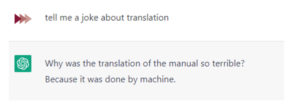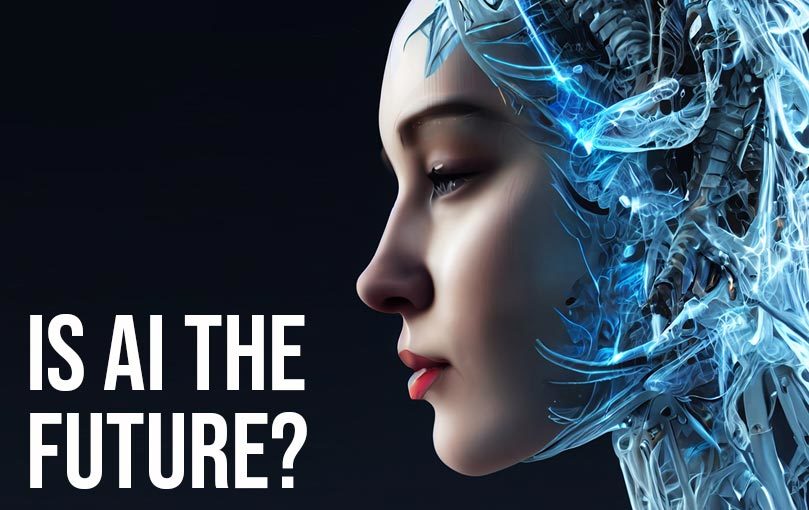Is the future of HR translation dependent on AI?
From Chat-GPT to DALL-e and beyond, Artificial Intelligence (AI) is having its moment. The translation industry is certainly not exempt from the hype. In fact, The Economist recently published a piece called “The Rise of the Cyborgs,” describing the translator of the future as a “human-machine hybrid.”
In a sense, this column is old news for those of us who work in the translation industry. And the columnist should be commended for observing that “There will still be a place for humans with specialist knowledge” in the brave new AI-driven world. Machine translation (MT) has been used for years to translate written content quickly. Ideally, this content is then proofread and polished by human translators to correct the inevitable errors that slip in.
However, it’s important for business leaders and human resources professionals to understand the limitations of this technology, especially for HR-related content.
Here are 3 reasons why you need well-trained human experts to take the lead on your next HR translation project.
Human Judgment and Understanding
Artificial intelligence and machine translation lack both.
Would you like proof? Go ask ChatGPT to tell you a joke about a specific topic. Say “Tell me a joke about human resources,” for example. Or try “tell me a joke about translation.”
Here’s a particularly telling example:

That’s unintentionally funny, but ChatGPT doesn’t understand why, because it doesn’t understand why anything is funny in the first place. Machine translation works by analyzing staggering amounts of data and learning to predict what comes next. It’s just putting words together that seem to fit the pattern of a joke.
Pattern Recognition
AI is all about pattern recognition. Human Resources work is often about changing existing patterns.
When artificial intelligence is fed data that reflects common biases in society, those biases show up in the output, as well.
That means AI output can be racist. Or sexist. This isn’t just a problem with AI chatbots or with large language models like GPT-3, which create content from scratch. It can affect machine translation of existing documents, too. For example, a 2019 study found that
“MT is skewed to the point of actually ignoring explicit feminine gender information in source English sentences. For instance, MT systems yield a wrong masculine translation of the job title baker, although it is referred to by the pronoun she.”
Human resources work is often focused on breaking these patterns: protecting employees from discrimination or sexual harassment. To do that effectively, you need experts who understand the issues in a way AI cannot, especially when there are multiple languages and cultures in the mix.
More than Just Words
When the goal is to change behavior (for example, to improve compliance with workplace safety practices), effective communication is essential. Often, translating words from one language to another is simply not enough. Cultural context matters, too. Sometimes, getting the cultural context right means choosing different references and examples. The Economist article gives the example of trying to find a reference to replace a short story that’s well-known in Spain but unheard of among English speakers.
Often, reimagining the content from the ground up leads to better outcomes. When workplace training is presented in a culturally relevant way, it’s more effective.
Here are just a few examples:
- Latin American women often prefer health and safety communications presented in the style of a fotonovela.
- For many immigrant communities, focusing on how following health and safety policies protects the workers’ families can increase compliance.
- Vietnamese fishermen provided with culturally appropriate safety training and images in their own language increased “intent to action” and higher attitude scores.
Machine translation can’t give you that. Human resources translation specialists can.
Language Access is a Human Right
Workplace safety is a vital part of compliance for businesses.
 Language access is crucial to protecting workers with limited English proficiency. The data clearly shows that immigrant workers are more likely to be injured or killed on the job. For example, overall workplace fatalities have gone down 20% in the last 10 years. That’s great news, except that for Hispanic workers, the trend is going in the opposite direction: workplace fatalities have actually risen almost 35% in the same period.
Language access is crucial to protecting workers with limited English proficiency. The data clearly shows that immigrant workers are more likely to be injured or killed on the job. For example, overall workplace fatalities have gone down 20% in the last 10 years. That’s great news, except that for Hispanic workers, the trend is going in the opposite direction: workplace fatalities have actually risen almost 35% in the same period.
Language barriers also contribute to non-fatal accidents and injuries. According to OSHA, language barriers are a contributing factor in 25 percent of job-related accidents. Accidents that lead to disabilities place a heavy economic burden on both workers and their families and on employers, with total costs to employers estimated at anywhere from $60B to $370B per year.
Employers have a moral obligation to make sure their employees know how to protect themselves. There’s also a legal obligation: OSHA requires employers to provide safety training in a language and at a vocabulary level that their employees can understand.
With so much at stake, employers can’t afford to leave anything to chance. And that means you need expert guidance to make sure that employees who don’t speak English (or who have limited English proficiency) aren’t falling through the cracks. MT is still not good enough on its own.
Human Resources Translation needs Humans
Machine Translation is just a tool for a job. Like any tool you need to be crafted in its use and be able to tell which tool is the right tool for the job.
So, what’s the solution?
It’s not about rejecting AI outright, but rather about using it intelligently. Machine Translation is simply a tool. Like any tool, it’s only as effective as the person who’s wielding it. Yes, in the right hands MT can lead to incredible gains in speed and efficiency. But if the translator of the future is a “cyborg”, half-man and half-machine, the real superpowers don’t come from the machine side. They are human superpowers: cultural understanding, empathy, and expertise born of experience and training.
At TransForma, our HR translation experts are here to help. We’re a boutique agency that places a premium on lasting relationships. That means we take the time to understand your business, and craft solutions that work for you.


